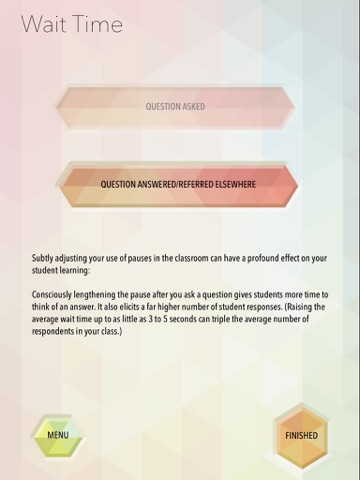
Peer observation is a proven strategy for increasing your effectiveness as a teacher. Research has shown that focused, specific, data-rich feedback and collegial conversations lead to real improvement in practice.
Each App in this suite is designed to give teachers feedback on one element of their practice. By inviting a colleague to observe your use of wait time after asking a question of students you’ll be best able to ensure students can answer thoughtful.
Wait time: Pie graph
What this App measures
This App measures the number of times that a teacher waits more or less than three seconds for a student response after asking a question and the average wait time for all questions recorded.
This App does not measure Pause time which is mentioned in the video as a complementary skill to Wait time.
Why that matters
Research by Rowe shows that wait time beyond 3 seconds increases the number of students who participate in discussions, increases the quality of responses, and limits ‘don’t know’ answers. See more on the video.
What you need to know to use this App effectively
The data collection relies on prompt recording by the observer. The first button should be tapped when a teacher colleague completes a question. A new button will then appear. This should be tapped when your colleague acts again, e.g. accepts an answer from a student, reframes or changes the question, asks a different student to answer either verbally or with a non-verbal gesture.
What does the data show
When recorded accurately the data will show what proportion of lesson time the teacher waited for more or less than 3 seconds for students to respond and will also calculate the average wait time across all recorded questions. Three seconds can seem a very long time!
How the data can be used in teacher coaching
The discussion between teacher and observer should quickly move from the recorded Wait time to the effect on student responses (and learning) of waiting for more or less time. It should also move into other techniques to extend wait time such as ‘Stop n’ Prop’, ’90 second countdown’ or ‘Many hands up’ (Pearsall 2012).



